Hakko Ryu Taikai 2018!

Welcome to your September 2018 issue of Shinbun: Hakko Ryu Taikai!
 Sensei Mike Wilson and I attended the 2018 Hakko Ryu Taikai outside of Boston, Massachusetts. 72 people (according to the group shot taken on Sunday) attended. Nidai Soke Sensei Okuyama attended, as did Joe Miller, Gil Adams, and many of the highest ranked players in the United States.
Sensei Mike Wilson and I attended the 2018 Hakko Ryu Taikai outside of Boston, Massachusetts. 72 people (according to the group shot taken on Sunday) attended. Nidai Soke Sensei Okuyama attended, as did Joe Miller, Gil Adams, and many of the highest ranked players in the United States.
The Taikai was Friday through Sunday, and further Shiatsu and Shihan training took place the following week. The new Shihans were reyed in the following weekend. Additionally, Mike and I (and the rest of the non-Shihans in attendance) had to leave the dojo space at 5:00 sharp each night, since Nidai Sensei Ryohu Okuyama was going to conduct Shihan review, and were not permitted (much to our consternation) to even observe.
 That indignity aside, Sensei Wilson and I had a great time, met some very good and decent people, saw a few amazing things for the first time, saw some new ways of doing some old things (or was that old ways of doing new things?) and were reminded of many, many things. And everything we practiced was done in the presence of Nidai Okuyama himself.
That indignity aside, Sensei Wilson and I had a great time, met some very good and decent people, saw a few amazing things for the first time, saw some new ways of doing some old things (or was that old ways of doing new things?) and were reminded of many, many things. And everything we practiced was done in the presence of Nidai Okuyama himself.
The weekend started with something that we can all use some reminding on: Etiquette. Friday morning began with an hour and a half of how to properly get on and off the mat. This was repeated and reviewed on Saturday morning, and on Sunday morning we all got a 45-minute lecture on how to place our sandals on the side of the mat before reying in (having collectively failed that test). As it turns out, the first two pages of the Hakko Ryu Shodan manual (after the introduction and history of Hakko Ryu) are dedicated to Seiza (Formal Kneeling Position) and Reigi No Koto (Techniques of Etiquette).
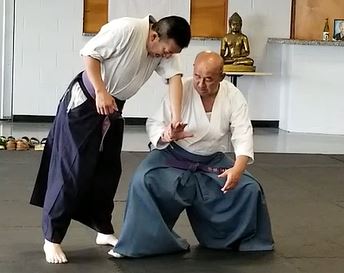
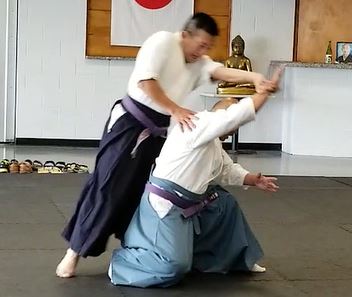
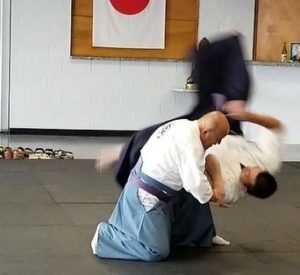
Nidai Soke Sensei Okuyama demonstrating Hakko Dan (8th degree) waza
Hakko Ryu and the Luck of the Draw

I met Shihan DePascuale in the summer of my junior year of high school, 1979. I went to the local dojo in my home town to learn how to fight, which, by chance, was owned and operated by him. My mother served him and his son Arnold Coffee at the Big E diner (not great tippers by all accounts). 15 years before that, by chance, Michael DePascuale needed a chiropractor, and a good local chiropractor (one town away, in Westwood, NJ) was Dr. S.R. Cohe. By chance, that chiropractor had a son who wanted to learn how to fight. After several visits the Yoshitsune Dojo, that chiropractor felt compelled (being a former college wrestler) to get on the mat. He never left it. By the time I showed up, in 1979, that chiropractor was the “sempai” of the Dojo. I studied with Shihan Cohe on Wednesdays, with Vince Menona on Mondays, and with Shihan DePascuale Sr. on Friday nights. By chance, I mentioned one night at the TAAZ Bar, to Shihan Cohe (who I did not know very well at the time) that, unbelievably, very few students attended the Friday night classes, and occasionally I was the only one there. Shihan Cohe stopped, turned to face me, and said with grave seriousness “That doesn’t matter…YOU show up!” And so, really for the first time, the lesson of “Rule #1: Show Up” was articulated unmistakably. I’m happy to stay that the lesson stuck. Many others as well. What disturbs me is how many turns of chance had to line up for this lesson, and all the subsequent lessons I’ve learned from Soke Sensei Cohe over the years, to happen for me.
 Sensei Mike Wilson and I met Shihan Sandaikichu Gil Adams. It became quickly obvious how much we don't know about Shiatsu, and how much that matters (a lot). I even discovered that there is such a thing as an "ankle gaukun." Shihan Adams walks with a cane, and he doesn't move terribly fast. And if I should have to go into a combat situation, I want to be on his side.
Sensei Mike Wilson and I met Shihan Sandaikichu Gil Adams. It became quickly obvious how much we don't know about Shiatsu, and how much that matters (a lot). I even discovered that there is such a thing as an "ankle gaukun." Shihan Adams walks with a cane, and he doesn't move terribly fast. And if I should have to go into a combat situation, I want to be on his side.

Belgian Stick Defense: "Giving the Weapon Back"

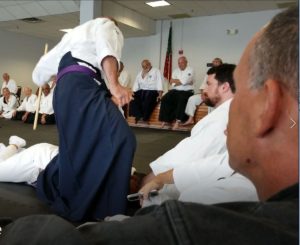

Each Sandaikichu Shihan was asked to demonstrate a unique defense against a stick, gun or knife attack. One senior shihan from Belgium did indeed have a unique technique of what Soke Sensei Cohe has always called "giving the weapon back." Sensei Wilson found this technique particularly useful and practiced it diligently against me for the rest of the weekend.

The senior leadership of the Hakko Ryu style disapproved of this technique thoroughly.
Hakko Ryu and Tsugiashi Do
Mike Wilson and I proudly wore our Tsugiashi Do insignias, both front and back, during the Taikai. One senior shihan, during a break, asked me about it. I said that while my sensei was a fully ranked Hakko Ryu Shihan, and that we were properly taught the Hakko Ryu waza through yondan, he did not think that moving, blocking, sidestepping, getting out of the way or into position was intuitively obvious and yet believed it to be critically important. The shihan nodded enthusiastically. I said that in order to perform Hakko Ryu effectively, you really need to be in the right place in relation to the opponent. Stronger nods. I added that our Soke didn’t think that any of his students had a particularly good memory, so he put a sort of “cheat sheet” on each of our backs. The shihan laughed and said “Good idea!”
The Way it Was: September 11, 2001
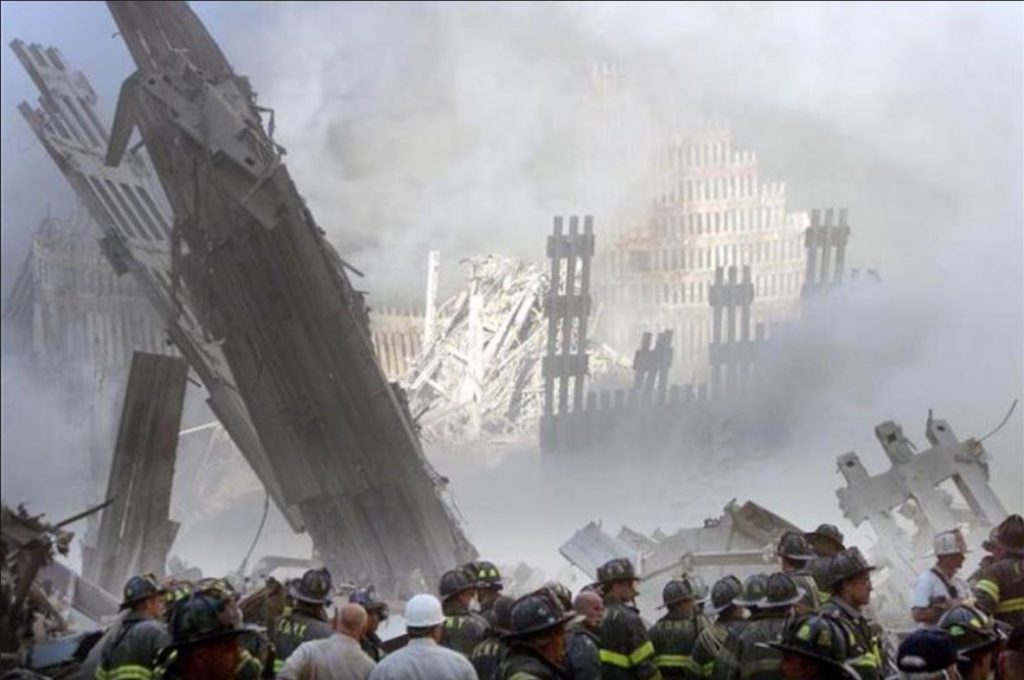
...And the Way it is Now: July 29, 2018

There was a fellow non-shihan with us at Taikai 2018 (non-Shihans were a minority there). Joe Torres was in hakama, and he was a legitimate and skilled practitioner. But he seemed to move not slower, not quite “stiffly” but more “carefully” than the rest of us, his eyes a bit more cautious around the falls. Mike mentioned that he had a ruptured disk. Sensei Joe Torres casually mentioned as we lined up for another demonstration, that he had 8 ruptured disks.
On the morning of September 11, 2001, NYPD Officer Joe Torres was in Lower Manhattan, at the World Trade Center, trying to clear the area of survivors and make way for emergency workers, when the South Tower began to fall. Joe Torres survived being trampled by hundreds of the escaping crowd, and then survived the rubble that fell on him. He subsequently survived 8 grueling operations and declined a 9th (it would ease more of the chronic pain he sustains but would make it impossible to move his hips and shoulders independently, thereby prohibiting him from practicing Hakko Ryu). 
And on Friday, July 27, he reyed in to Taikai 2018 with us, and even performed his nidan demonstration for Soke Sensei Okuyama.
There is a tradition in the U.S. Military that lower ranks salute upper ranks, not unlike most martial arts. However there is one notable exception to this tradition: Holders of the Congressional Medal of Honor are saluted by all ranks, regardless of seniority. I’ve met two such recipients: Paul Bucha (who lives in my town) and Jack Jacobs (who speaks at my company’s veterans gatherings). Neither are large men, neither appear picturesque or outwardly heroic, both are unassuming, modest, and credit their men and luck for their survival. Paul Bucha told me in the CVS parking lot “I didn’t win the medal, my men did; I lived.” The only thing observably superhuman on these men is their humility. I found a similar demeanor in Joe Torres. If he visits us, or if we visit him, I will insist that we rey to him, regardless of rank.
September 28, 2018
Nice job Scott!
October 4, 2018
Scot,
Great Job. Brought back a lot of memories and super current information and anecdotes. I can’t begin to tell you how pleased my father was that you have carried on this tradition.
Thank you and best to all… Shaw Cohe